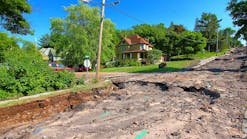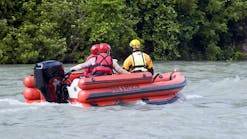Evaluating Economic Risks & Opportunities of a Flooded Future
by Katerina Oskarsson & Paul A. Robinson
The impact of climate change is being experienced at an accelerated rate and coastal communities are on the front lines. Nearly half of the U.S. population lives in areas vulnerable to sea level rise, leaving them at higher risk for shoreline erosion, flooding and intense storms.
These hazards now threaten approximately $1 trillion in real estate and infrastructure along U.S. shores, and researchers say coastal flooding events could cost up to $14.2 trillion worldwide by the end of the century.
Preparing to react to more regular, widespread and severe coastal inundation may help save money while lowering cascading economic impacts. An analysis by the U.S. EPA suggests adaptation – employing tools and techniques to help adapt to new climate conditions – is an important, cost-effective way to enhance resilience. Additionally EPA indicates that damages to U.S. coastal properties and infrastructure, such as storm water systems, would be significantly reduced if protective adaptation measures were implemented.
But climate adaptation is not a one-size-fits-all process. It requires a holistic, long-term perspective, taking into account the frequency of natural and manmade shocks. Successful plans incorporate the kind of investment (and infrastructure) that will protect vulnerabilities well into the future complemented by a range of innovative, affordable solutions that help reduce risk now.
The recent federal prioritization of infrastructure, coupled with an increased focus on coastal resilience adaptation, offers unprecedented funding opportunities for businesses developing innovative products and services related to both sectors. But many resilience solutions are envisioned without ever being tested in the real world. The experimentation needed makes the identification and scaling of the most catalytic, thought-provoking ideas incredibly challenging and increasingly important.
As the demand and market for next-generation resilience products grow, coastal Virginia has emerged as the premier living laboratory for innovators and businesses of all sizes interested in testing, validating and demonstrating their novel solutions. By collaborating across sectors and tapping into its unique strengths, the region has turned climate resilience into an economic driver.
A Trifecta of Flood Hazards
With its low elevation, long shoreline and some of the highest rates of relative sea level rise along the East Coast, coastal Virginia is particularly vulnerable to flooding. The land itself — a mix of river delta and glacial outwash plain — is an area with a high risk of inundation from rivers, rainwater runoff, and even flooding during normal conditions due to the tides.
Amplifying these issues is the rapid growth of the Hampton Roads region, which is second only to New Orleans as the largest population center at risk from sea level rise in the country. Nearly 1 million people live in a 10-mile radius in Hampton Roads, and there is limited room for new infrastructure to accommodate flooding and storm water management. Aging systems are unable to keep pace with rising seas, rainwater, and flooded streets – particularly in underserved communities, who often bear the brunt of storms.
Using Innovation to Build a Resilient Future
In 2017, the Department of Housing and Urban Development (HUD)’s National Disaster Resilience Competition gave out nearly $1 billion to 13 states and communities. Virginia received $120 million, $5 million of which went toward launching a first-of-its-kind “coastal resilience lab and accelerator,” an innovation hub dedicated to finding and testing novel solutions that help us adapt to the increasing effects of climate change.
Today, that hub is the nonprofit organization, RISE: a one-stop shop for resilience innovation in the U.S. Since 2018, RISE has deployed over $5 million to more than 30 companies through Challenges – innovation-fueled pitch competitions – that source and scale the best climate resilience solutions from across the globe and bring companies together to solve the many problems rural and urban coastal communities are facing.
Environmental Challenge Becomes Economic Opportunity
With RISE as the delivery vehicle, coastal Virginia serves as the national model for how resilience innovation can be used to achieve environmental resilience and economic development objectives.
In addition to catalytic funding and mentorship, winning businesses get a full value chain of services, including access to physical infrastructure as a living laboratory to demonstrate and refine their products.
RISE identifies the most suitable pilot sites, coordinates the installation process, develops an execution and evaluation plan and facilitates business development. From ideation to implementation, on average, Challenge winners spend a year building and deploying their solutions within a local pilot community of business, government and tech leaders, generating real-time feedback on what is working and what is not. And by demonstrating their product in real-world conditions, companies can also access larger markets.
Municipalities get de-risked solutions that can be implemented in the near-term. Working with localities to leverage their resilience needs, procurement and collective purchasing power attracts more businesses with more effective solutions.
Application in Virginia
A recent example is StormSensor, a Seattle-based climate tech startup. Within a month of winning a RISE Coastal Community Resilience Challenge, StormSensor had more than 20 sensors installed in the city of Norfolk's storm water pipes collecting data on tidal backflows and measuring storm water capacities in some of the city’s most flooded neighborhoods. The findings were startling: due to sea level rise, the city's storm water system's main lines were half-full of water, severely restricting their capacity to handle large rain events.
The city is now using the data to provide real-time backflow alerts, prioritize retrofits, and to adapt future storm water system plans. And based on the successful pilot, the city looks likely to procure StormSensor’s technology to address its current and future needs.
From affordable bioswale kits to trenchless pipe-laying technology, there are currently more than 20 pilot projects in coastal Virginia, all investigating new ways to help coastal communities adapt to climate change.
Companies temporarily relocate, add satellite offices or hire local workers to help install and maintain equipment during pilot projects, bolstering the economy. And several businesses have permanently relocated to the region following their pilot projects with plans to expand.
The threats of a coastal region do not need to be doom and gloom. By approaching these issues thoughtfully with their partner stakeholders, RISE has shown how it may be turned into opportunities leading to jobs, growth and innovative solutions.
About the author:
Paul A. Robinson, Ph.D., is executive director of RISE. Robinson can be reached at [email protected].
Katerina Oskarsson, Ph.D., is chief strategy officer of RISE. Oskarsson can be reached at [email protected].






